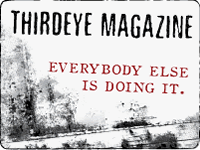TE: For average people, especially young people, who want to make the world a better place, what is your advice on how to plug in without wasting energy on lost causes?
KA: Everyone needs to recognize that we are truly in a crisis. This is the first time in history that this has ever happened. We have the ability to destroy the conditions conducive to life on a global scale. I mean, it’s happened to at least five or six previous civilizations, but it was always localized. Basically, when people exceeded their ecological limits, their societies very quickly declined and often became extinct. But never before has it been globalized. This is the real deal, and we all have to get involved. So I think the first thing you need is a commitment to get involved, and from there it’s going to be very different for each person. My advice is basically to educate yourself, and in the process of educating yourself find out where your heart really resonates. Maybe you especially care about water or animals or social justice or health. Once you’ve zeroed in on what your real passion is, think about what your personal gifts are and then get connected. Find out who’s working in those fields, what cool groups or individuals are out there, and approach them and see if there’s a way you can get involved. Either in your community or on a national scale, or whatever is right for you. Perhaps it’s going to the Traverse City Bioneers and meeting someone there. I’ve heard stories of people who went to a Bioneers conference, got really lit up by it and met somebody, and now they’re working for that group or they’ve found their path. But once you set that intention, things will happen and you just have to have confidence in that. I think in the world right now we face attention deficit disorder, and we need to resolve that. We need to set a very strong intention that we’ve got to get together and solve these problems, and then things will take care of themselves.
TE: Can you elaborate on the concept of restoration as being the guiding principle of the Bioneers, versus sustainability?
Sustainability is the midpoint between two eternal cycles in life – destruction and restoration.
KA: You bet, and I want to acknowledge Paul Hawken who is really the one who keyed into this about ten years ago or so. Sustainability is the midpoint between two eternal cycles in life – destruction and restoration. Things are always dying and things are always being born. If you are a gardener you understand that through the process of composting. Sustainability is really the midpoint between those two processes, and the real idea of it is simply that you leave the world a little better than you’ve found it. That you give back as much as you take. The problem is that as a species we’ve done so much damage that the world is radically degraded; ecosystems are breaking down. So it isn’t really enough to just sustain what we have right now, we actually need to give back more than we’re taking, because there’s a lot to restore before we can get back to that midpoint of sustainability.
TE: There has been much comparison with the Bioneers movement and a worldwide popular movement described by Paul Hawken in his forthcoming book, “Blessed Unrest.” What is this global movement and how do the Bioneers relate?
KA: What Paul has documented is literally the biggest movement in the history of the world. He’s done a whole web database search and come up with somewhere between one and two million groups worldwide like Bioneers, like what you guys are doing in Traverse City, everywhere. Most of it is coming through civil society, through the nonprofit sector. I witness more and more of it coming into local and regional governments. It’s cross-cultural, it’s every race and culture on the planet, and what it’s fundamentally about is taking care of our ecosystems and restoring our environment. It’s about justice. It’s about having equity in the world and a sense of reciprocity, and, as Paul describes it, it’s a movement of movements. So you can break it out into all these different categories, like the environmental movement, or the social justice movement, or the peace movement, but it’s bigger than any one of those and bigger than even all of those put together. And it’s very decentralized, it’s not hierarchical in the traditional sense – although there are many, many leaders. Biologists say that the surest way to heal an ecosystem is to connect it to more of itself. And that’s what we’ve been doing partly through Bioneers; not only putting out the solutions but helping people get connected. In a sense, Bioneers are a microcosm of this larger movement, because we represent all the different issues and many different points of view. We don’t say or believe that there’s one way to solve a problem; there are many, many approaches and we need all of them. What you understand when you look at ecology is it’s all made up of different little niches, and everything depends on everything else. So what we present at Bioneers is kind of a social ecology, of many different approaches, some of which sometimes even contradict one another.
TE: Up to now, Bioneers has been very comprehensive and worked very hard on forming connections between activists working on a myriad of issues. Are there any plans to zero in and focus on some more specific issues or areas of concern as things become more pressing, or are you going to maintain the same kind of holistic approach?
KA: Well I think that we’ll always maintain the holistic approach, and at the same time you have to stay open to whatever life may throw at you, so we don’t really know. But we’ve been in a process internally of just drilling down and going deeper and deeper into different areas – like water, like energy, like food and farming, like public health – and continuing to build these networks. And we’re trying to sort of bring together more and more coherence to those networks, and gather some of the key learnings from those different sectors. What we’re witnessing right now, the kind of thing that’s going on in Traverse City, is actually the most important direction that the work is taking, and that’s localizing the work. I believe that if we’re building a long-term movement that’s truly going to be sustainable, it must come from the ground up. And that’s not to negate leadership at a national level or anything of that nature, but if you build it from the ground up then it’s going to have strength and durability. And then what we also need to do at the same time is get connected horizontally, across all of our local communities, so we can share what we’re learning and share solutions and get to know each other as well. So I think that the localization is a major trend. We’re looking at doing some work in New Mexico, which is where our main face is – that’s where we all live and so forth – and so we’re very interested in getting more involved in our place and seeing how that goes.
TE: It seems in life it often takes catastrophe to catalyze individual growth. In the same way, do you feel the types of global catastrophes we’ve been discussing have the potential to force our species to enter a new period of worldwide Renaissance?
there’s a global ecological enlightenment underway.
KA: I do. David Orr, who’s been the dean of environmental studies at Oberlin College, suggested there’s a global ecological enlightenment underway. In a sense, we’re getting an environmental education the hard way with Katrina, or the tsunami, or all these things that are happening. What’s becoming clear is that we can’t avoid these issues; I think there’s been a lot of denial that there’s a problem, and my own perception is that’s lifting pretty quickly. There’s a pretty big push to start changing how we do business and how we live on this Earth. Global warming is absolutely pushing that. It was very encouraging to me to see how many people have gone to see the new Al Gore movie. And there’s tremendous changes happening in industry as well. Green technology, green chemistry. There’s so many advantages for the companies in this regard, because 94% of our industrial system is waste. And if you look at that differently, there’s a huge business opportunity because waste is very costly, and there’s a lot of liability involved. So companies like DuPont and 3M, the big dogs, are very interested in green chemistry, which basically is harmless. That’s the whole point of it, that you don’t produce these toxins, that you don’t produce this waste in the first place. So I think that there will be an important drive coming from business over the next five or ten years and the world’s going to look very, very different. And we’ve obviously got to make the transition to renewable energy as quickly as we possibly can. It’s still stuck in a lot of politics, but I think it is shifting and it will continue to shift.
TE: Is there anything else you’d like to tell activists in the Great Lakes region?
KA: Well, I just want to thank all of you for your inspiration, for really taking care of your place, for taking care of each other, and for educating people. What you’re doing is so important, and we’ve got to take the long view here. So much work has already been done and it’s going to continue to accelerate. So I think there’s a tremendous amount of hope coming out of people exactly like you, and we are everywhere. It’s important that we keep on keeping on, get better connected with each other, and keep the faith.
Part of what I’ve seen in Bioneers is that the solutions residing in nature continually surpass our perception of what’s even possible. There’s great hope in the sense of how little we know at this point; we’re really just learning. And there’s great hope in the little that we do know; these solutions are incredibly powerful. We’re also witnessing what John Todd calls, “human ingenuity wedded to the wisdom of the wild.” That people are so brilliant and so creative, and so many people have so much courage and so much heart, so all over the world right now there are these explosions of creativity. People are coming together in community, and that’s really where our ultimate social security lies. What’s going on in Traverse City is one of the great models to me of just exactly where the hope is.
Pages: 1 2





No Comments so far ↓
There are no comments yet...Kick things off by filling out the form below.